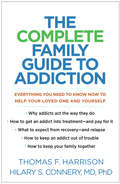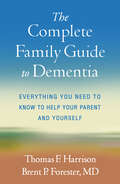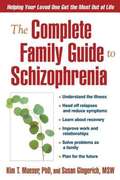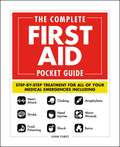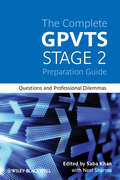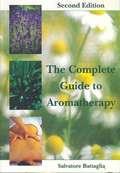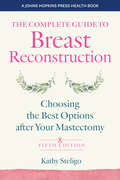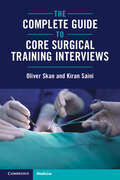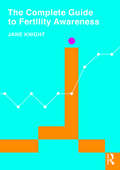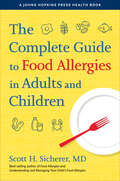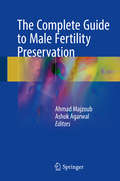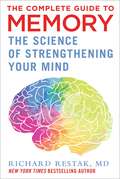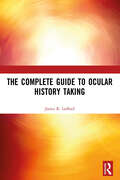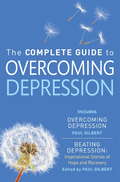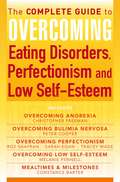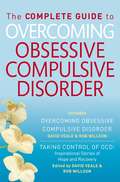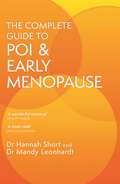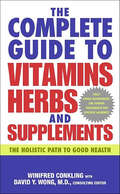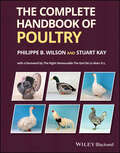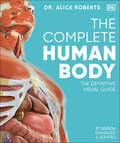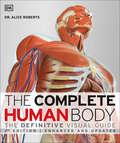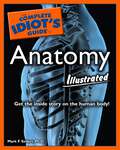- Table View
- List View
The Complete Family Guide to Addiction: Everything You Need to Know Now to Help Your Loved One and Yourself
by Thomas F. Harrison Hilary S. ConneryIf you are struggling to help a loved one recover from addiction--and to cope with the devastating impact on the whole family--you are not alone. But until now, there has been no single book that gives the millions of families like yours the comprehensive, unbiased information you need. This expertly written guide addresses the painful questions that spouses, parents, and grown children face every day. Why do addicts make such bad choices? How can you find (and afford) treatment that works--and convince your loved one to try it? Can relapse be prevented? When does being supportive cross the line to enabling? Providing science-based answers and resources, the authors cover crucial emotional, financial, and legal issues that simply aren't discussed in other books. The more your family knows about the myths and realities of addiction, the better equipped you will be to overcome it.
The Complete Family Guide to Dementia: Everything You Need to Know to Help Your Parent and Yourself
by Brent P. Forester Thomas F. HarrisonIf you are facing the unique challenges of caring for a parent with dementia, you are not alone. What do you do when your loved one so plainly needs assistance, but is confused, angry, or resistant to your help? Where can you find the vital information you need, when you need it? Journalist Thomas Harrison and leading geriatric psychiatrist Brent Forester show that you don&’t have to be a medical expert to be a good care provider in this authoritative guide. They explain the basics of dementia and offer effective strategies for coping with the medical, emotional, and financial toll. With the right skills, you can navigate changing family roles, communicate better with your parent, keep him or her safe, and manage difficult behaviors. Learn how to "care smarter, not harder"--and help your loved one maintain the best possible quality of life.
The Complete Family Guide to Schizophrenia
by Susan Gingerich Kim T. MueserWill the person you love ever get better? Chances are you've grappled with the question. With care and support from their families, people with schizophrenia can and do make vast improvements. Noted therapists Kim Mueser and Susan Gingerich deepen your understanding of the illness and cover a wide range of effective treatments. Based on decades of research and experience, they offer pragmatic suggestions for dealing with depression, psychosis, and other symptoms. They show you how to prioritize needs, resolve everyday problems, and encourage your loved one to set life goals. Plus, individual sections highlight special issues for parents, children, siblings, and partners. Whether you're facing schizophrenia for the first time or you've dealt with its impact for years, you'll discover innovative ways to handle challenges that arise over the course of treatment, from reducing the chances of relapse to making friends and finding work. Recovery isn't an endpoint--it's a lifelong journey. With love, hope, and realistic optimism, striving for it can lead to a richer, more rewarding life for your entire family. Winner, NAMI/Ken Book Award
The Complete Family Guide to Schizophrenia: Helping Your Loved One Get the Most Out of Life
by Kim Mueser Susan GingerichWill the person you love ever get better? Chances are you've grappled with the question. With care and support from their families, people with schizophrenia can and do make vast improvements. Noted therapists Kim Mueser and Susan Gingerich deepen your understanding of the illness and cover a wide range of effective treatments. Based on decades of research and experience, they offer pragmatic suggestions for dealing with depression, psychosis, and other symptoms. They show you how to prioritize needs, resolve everyday problems, and encourage your loved one to set life goals. Plus, individual sections highlight special issues for parents, children, siblings, and partners. Whether you're facing schizophrenia for the first time or you've dealt with its impact for years, you'll discover innovative ways to handle challenges that arise over the course of treatment, from reducing the chances of relapse to making friends and finding work. Recovery isn't an endpoint--it's a lifelong journey. With love, hope, and realistic optimism, striving for it can lead to a richer, more rewarding life for your entire family.
The Complete First Aid Pocket Guide: Step-by-Step Treatment for All of Your Medical Emergencies Including • Heart Attack • Stroke • Food Poisoning • Choking • Head Injuries • Shock • Anaphylaxis • Minor Wounds • Burns
by John FurstFrom minor cuts and burns, to heart attacks and strokes, this handy, take-anywhere guide gives you the knowledge and advice you need to recognize and respond to any medical emergency.Be prepared for any medical emergency and handle it safely and efficiently with The Complete First Aid Pocket Guide. Quickly identify signs and symptoms of a wide range of medical conditions andlearn how to recognize the difference between a minor injury or illness, and those that are more serious with this essential handbook. Each section of The Complete First Aid Pocket Guide includes a quick list of signs and symptoms to look for and step-by-step first aid instructions for dealing with each situation, all in user-friendly, simple language that&’s easy to understand. Medical issues covered include: —First aid basics, including roles and responsibilities of a first aider, managing an incident, activating emergency services, and infection control —Lifesaving skills including the recovery position, cardiopulmonary resuscitation (CPR), and use of an automated external defibrillator (AED) —Minor injuries and conditions, including soft tissue injuries, splinters, blisters, eye injuries, nosebleed, diarrhea, and vomiting —Traumatic injuries including severe bleeding, amputation, shock, fractures, crush injuries, burns, and head and neck injuries —Medical emergencies including heart attack, stroke, asthma, anaphylaxis, hypoglycemia, meningitis, seizures, poisoning, and emergency childbirth —Environmental conditions including hypothermia, frostbite, heat stroke, sunburn, and lightning strike —Pediatric emergencies and illnesses, including assessing an unresponsive child or baby, pediatric cardiopulmonary resuscitation (CPR), choking, croup, and febrile seizures —First aid kit lists for home, vehicles, and outdoor use With an appendix featuring an A-to-Z list of every condition covered, it&’s easy for you to quickly find the exact information you need in any situation you may face. With its small trim and portable size, The Complete First Aid Pocket Guide is the perfect addition to a home first aid kit, car first aid kit, disaster-survival bag, as well as a pocket companion for EMTs and other first responders in the field.
The Complete GPVTS Stage 2 Preparation Guide: Questions and Professional Dilemmas
by Saba Khan Neel SharmaEase the pressure of the GP Vocational Training Scheme Stage 2 exams, and ensure your progress to Stage 3, with this complete preparation guide Featuring all question types from the exam, including SBAs, EMQs and Professional Dilemmas, and covering a range of medical and surgical specialties, this invaluable guide not only tests appropriate application of clinical knowledge, but encourages doctors to think logically and ethically - vital in recognising appropriate behaviour in professional dilemmas. The opening section provides handy advice on how to prepare for the exam and explains what the question setters are looking for - the key to success in Stage 2. Based on the contributors’ own experience of typical problems and dilemmas, and including thorough explanations for each answer, this book is not just an exam crammer, but a valuable learning tool.
The Complete Guide to Aromatherapy
by Salvatore BattagliaA wide-ranging guide to aromatherapy, including units on its background, essential issues, remedies, practical matters, clinical index, aesthetic aromatherapy, 8 appendices and 2 indices.
The Complete Guide to Breast Reconstruction: Choosing The Best Options After Your Mastectomy (A\johns Hopkins Press Health Book Ser.)
by Kathy SteligoThe Complete Guide to Core Surgical Training Interviews
by Oliver Skan Kiran SainiWritten by the candidates who ranked first and second nationally in the 2023 Core Surgical Training (CST) application process, this book is a definitive guide to success in the CST interview. This book takes candidates through the CST interview process, covering all of the clinical, ethical, and leadership components that an applicant can expect to be tested on. Over 55 clinical and ethics-based cases and hundreds of interview questions are used as part of a spiral curriculum that covers common stations and helps to build a replicable approach to each station. It also covers important aspects of communication and presentation skills. The authors share their tips and tricks for scoring highly, helping candidates to maximise their chances and stand out in a highly competitive field. This book will be an invaluable resource for foundation-year doctors and international medical graduates preparing to apply for CST.
The Complete Guide to Fertility Awareness
by Jane KnightFertility Awareness is key to understanding sexual and reproductive health at all life stages. It can be used to either plan or avoid pregnancy. Fertility Awareness Methods (FAMs) are highly effective when motivated couples are taught by trained practitioners. These methods are in demand for ecological, medical, cultural, religious and moral reasons. The ability to control fertility naturally is a lifestyle choice. The Complete Guide to Fertility Awareness provides the science and methodology suitable for health professionals and a general audience. It covers reproductive physiology and the fertility indicators: temperature, cervical secretions and cycle length calculations. It explores ways to optimise conception and to manage conception delays. Case studies and self-assessment exercises are included throughout. The book addresses the scientific credibility of new technologies including fertility apps, home test kits, monitors and devices. The Complete Guide to Fertility Awareness offers: evidence-based information for general practitioners, practice nurses, school nurses, midwives, sexual health doctors and nurses a unique perspective on subfertility for gynaecologists and fertility nurses an authoritative source of reference for medical, nursing and midwifery students a straightforward and practical reference for new and experienced FAM users the core text for the FertilityUK Advanced Skills Course in Fertility Awareness
The Complete Guide to Food Allergies in Adults and Children (A Johns Hopkins Press Health Book)
by Scott H. SichererThe most complete guide to preventing, testing, living with, and treating food allergies in children and adults.In this comprehensive, evidence-based guide for adults and children with food allergies and those who care for them, Dr. Scott H. Sicherer provides all the critical information you need on preventing, testing, living with, and treating food allergies. Organized in an accessible Q&A format and illustrated with case studies, the book thoroughly explains how to prevent exposure to a known allergen at home, at work, at school, in restaurants, and elsewhere. Emphasizing the most recent advances, Sicherer touches on everything from handling an anaphylactic emergency to diagnosing allergies and intolerances, all while detailing chronic health problems caused by food, such as eczema, hives, and gastrointestinal symptoms.He also shares:• the benefits and risks of new therapies• new prevention guidelines• new approaches to improve quality of life and reduce anxiety• the latest insights on adult-onset food allergies• new diagnostic tests now commercially available• approaches shown to increase safety in school• the latest thinking on treating eczema through the diet• new doses and self-injection devices for treating food anaphylaxis• new information about food allergies that affect the gutDr. Sicherer also reviews food reactions that are not allergic, such as lactose intolerance, irritable bowel syndrome, and celiac disease. He explains how to get adequate nutrition when you must avoid dietary staples and discusses whether allergies ever go away (they do—and sometimes they return). Finally, he includes an allergy and anaphylaxis emergency plan and checklists to reduce cross-contamination. This is the most authoritative and accessible allergy book on the market.
The Complete Guide to Male Fertility Preservation
by Ashok Agarwal Ahmad MajzoubThis comprehensive, multidisciplinary guide provides an up-to-date presentation of fertility preservation techniques with male cancer patients and other challenging conditions. Divided into four thematic sections, part one provides an overview of the pathophysiologic processes interrelating cancer and its treatment with infertility and discusses different methods of sperm preservation and fertility outcomes in cancer patients. Part two then explores male fertility preservation in various non-cancerous conditions, such as immunosuppressed, hypogonadal and transgender patients. The fundamental principles of cryobiology and sperm optimization are covered in part three, which also offers essential building blocks for scientists to develop a sperm banking service and implement high standards of practice. The final section describes the current practices of male fertility preservation along with its psychological impact on patients, and extends beyond to future innovative methods--tissue preservation, xenografting and artificial gametes--being researched and implemented in this field. Fertility preservation among cancer patients and survivors is an evolving practice, which involves focused research and timely collaboration of professionals from related fields. The Complete Guide to Male Fertility Preservation is unique and original in its design and will appeal to a larger audience of andrologists, reproductive endocrinologists, urologists, embryologists, and all other clinicians practicing reproductive medicine and oncology.
The Complete Guide to Memory: The Science of Strengthening Your Mind
by Richard RestakA comprehensive guide to understanding how memory works, how memory forms, the mind-body connection, and more! In the busy, information-filled world in which we live, it&’s often easy to forget things and hard to keep track of how details get stored in our brain. The Complete Guide to Memory serves to provide a one-stop resource that covers the essentials on memory. World-renowned memory expert, Dr. Richard Restak, addresses the following topics in detail: How memories formThe different kinds of memoryChanges in brain structureThe mind-body connectionThe relationship between memory and emotional regulationAnd much more! With tips and tricks to manage memory well for people of all ages and personal examples of the techniques used, this book leaves no stone unturned.
The Complete Guide to Ocular History Taking (The Basic Bookshelf for Eyecare Professionals)
by Janice K. LedfordThe Complete Guide to Ocular History Taking discusses many questions involved in obtaining a complete history of the patient. It offers specific questions for the technician to ask the patient in the exam room and during the history-taking process. This book advises you on condensing a narrative, patient confidentiality, and developing patient rapport. It also provides notes on ocular and systemic medications which will help you look up medications in pharmaceutical references.This text discusses questions regarding ocular and systemic disorders, visual and physical symptoms, and medications. It also covers questions on trauma, gout, arthritis, and diabetes as well as questions for specific groups of patients such as postoperative, pregnant, geriatric, or children. Over 40 common ocular diagnoses are listed with questions to ask at follow-up visits. This text is ideal for on-the-job training or can be used as a handy reference tool while administering an exam.Special FeaturesList of common ophthalmic abbreviations used in history taking. Provides notes on Health Care Financing Administration (HCFA) coding. List of systemic diseases and where they fit under review of systems. Discusses drugs that affect the eye.
The Complete Guide to Overcoming Depression: (ebook bundle)
by Prof Paul GilbertThe bestselling self-help guide Overcoming Depression has been combined with Beating Depression: Inspirational stories of hope and recovery to offer the reader an effective and appealing self-help package. These two titles not only set out practical techniques to overcome depression, but offer inspiration to the reader to confront the challenges they may face on the road to recovery.Overcoming Depression is based on Cognitive Behavioral Therapy (CBT), an evidence-based therapy recommended by the NHS. It provides:-Useful information about the disorder-A step-by-step self-help programme based on CBTBeating Depression contains real-life stories written by those with first-hand experience of depression, including postnatal depression and bipolar disorder. Each story sheds light on the condition, and offers powerful insights into what helps and, most importantly, inspiration to those trying to beat it.
The Complete Guide to Overcoming Eating Disorders, Perfectionism and Low Self-Esteem (ebook bundle)
by Roz Shafran Constance Barter Tracey Wade Sarah Egan Dr Christopher Freeman Dr Melanie Fennell Prof Peter CooperEating disorders, such as anorexia nervosa, bulimia nervosa and binge and disordered eating, affect a significant proportion of the general population. They can cause untold suffering to those with the disorder, and those around them, who find themselves at a loss how to help their loved one. For the first time, this unique bundle combines hope and inspiration to those experiencing eating disorders either first-hand or up close. Includes: self-help programmes for the eating disorders and the inspirational diary of recovery written by an ex-sufferer of Anorexia Nervosa, now a Youth Ambassador for Beat, the Eating Disorders association.Includes the following: Overcoming Anorexia Overcoming Bulimia Nervosa & Binge-Eating Overcoming Perfectionism Overcoming Low Self-Esteem Mealtimes & Milestones
The Complete Guide to Overcoming OCD: (ebook bundle)
by Rob Willson David VealeThe bestselling self-help guide Overcoming Obsessive Compulsive Disorder has been combined with Taking Control of OCD: Inspirational stories of hope and recovery to offer the reader an effective and appealing self-help package. These two titles not only set out practical techniques to overcome obsessive Compulsive Disorder (OCD), but offer inspiration to the reader to confront the challenges they may face on the road to recovery.Overcoming Obsessive Compulsive Disorder is based on Cognitive Behavioral Therapy (CBT), an evidence-based therapy recommended by the NHS. It provides:-Useful information about the disorder-A step-by-step self-help programme based on CBTTaking Control of OCD contains real-life stories written by those with first-hand experience of OCD. Each story has been especially selected by Dr David Veale and Rob Willson and together they reflect the broad range of different experiences and stories of OCD. Each story sheds light on the condition, and offers powerful insights into what helps and, most importantly, inspiration to those trying to beat it.
The Complete Guide to Overcoming Traumatic Stress (ebook bundle)
by Claudia Herbert Ann Wetmore John MarzillierTerrible events are very hard to deal with. Those who go through a catastrophic life experience, such as a car accident, assault, long-term abuse, an illness or bereavement, often feel permanently changed by the impact of what has happened. They become numb and shut off from those around them, or grief or guilt may constantly weigh them down. Memories of horrifying scenes may intrude unexpectedly during waking hours while sleep may be disturbed by vivid, unpleasant dreams. These two practical guides on trauma and how to cope with its aftermath are written by internationally recognise trauma experts.Overcoming Traumatic Stress - Claudia Herbert & Ann WetmoreBased on cognitive behavioural therapy (CBT), this self-help guide offers a step-by-step programme to help you to understand your traumatic experience and how it's affecting you, and to start to rebuild your life. Traumatic stress responses, including Post-Traumatic Stress Disorder (PTSD) result from a person's coping mechanisms having been completely overwhelmed by a terrible experience. 'Flashbacks' may be so severe that sufferers may feel that they are losing their sanity and subsequently become ever more isolated in their distress. To overcome the effects of trauma it is necessary to change those reactions and begin to see events in a different light. This book demonstrates, with practical advice and tested exercises, how to find new, effective ways of coping with, and finally overcoming traumatic stress.To Hell and Back - John MarzillierIn this innovative and engaging book, world-renowned psychologist John Marzillier dovetails first-hand accounts from trauma sufferers with over 40 years of clinical practice to provide an honest, human description of how trauma affects us at the time and also after the event.Whether discussing accounts of terrorist bombings, natural disasters, road accidents or physical attacks, he looks at what these experiences do to us and offers practical and consoling advice - for both sufferers and their loved ones - on coping with the experience and developing resilience for the future.
The Complete Guide to Overcoming depression, low mood and other related problems (ebook bundle)
by Colin Espie Dr Melanie Fennell Prof Paul Gilbert Dr William Davies Professor Jan Scott MD, FRCPsychThis exclusive ebook bundle comprises five practical self-help programmes based on cognitive behavioural therapy (CBT) from the bestselling Overcoming series. Perfect for anyone experiencing problems with low mood or depression and associated problems such as low self-esteem, anger or sleep problems. This is also the perfect resource for therapists.Each book includes:-Case studies-Practical exercises-Monitoring sheetsOvercoming Depression - 3rd editionIf you suffer from depression you are far from alone. Depression is very common, affecting over 300 million people around the world. Written by Professor Paul Gilbert OBE, internationally recognised for his work on depression, this highly acclaimed self-help book has been of benefit to thousands of people including sufferers, their friends and families, and those working in the medical profession.This fully revised third edition has been extensively updated and rewritten to reflect over ten years of new research on understanding and treating depression, particularly the importance of developing compassionate ways of thinking, behaving and feeling.Overcoming Mood SwingsMost people know what it is like to experience high or low spirits. For some individuals, however, emotional extremes can seriously disrupt their lives, either because they happen too frequently or because the mood swings are intense and are accompanied by other symptoms of depression or mania (often referred to as bipolar disorder).This practical self-help guide provides background information on depression and mania and offers tried and tested techniques that will help the reader identify and manage their mood more effectively, and achieve a more stable emotional state.Overcoming Low Self-EsteemA self-help classic, winning acclaim for its practical and user-friendly approach and now recommended on the National Health Service's self-help scheme known as Books on Prescription. This book will aid readers to understand what has caused their low self-esteem and, with this knowledge, break out of the vicious circle of negative self-image, learn the art of self-acceptance and alter their lives for the better.Overcoming Anger and IrritabilityAn invaluable self-help guide to managing a widespread behavioural problem. This is a practical self-help programme for those who find that they are spoiling the lives of both themselves and those around them with their almost constant irritability and flashes of bad temper. It will help the reader understand why such behaviour occurs and what can be done to prevent it.Overcoming InsomniaExtensive research conducted over 25 years has established Cognitive Behavioural Therapy (CBT) as the treatment of choice for insomnia. For the first time, proven CBT principles have been brought together by a world-renowned expert on insomnia in a comprehensive self-help manual. In a clear step-by-step approach, new patterns of relaxation, sleeping and waking are quickly learnt. Based on clinically proven techniques.
The Complete Guide to POI and Early Menopause
by Dr Mandy Leonhardt Dr Hannah ShortSupport for every stage of your journey through early menopause and Premature Ovarian Insufficiency.Finding out in your teenage years or early twenties that you are menopausal can be devastating; receiving the same diagnosis in your late thirties is overwhelming; learning that you are post-menopausal while undergoing fertility treatment in your early forties may leave you blind-sided. This is not the more natural, expected hormonal transition at mid-life that other, older women experience. The Complete Guide to POI and Early Menopause offers a road-map to navigating the emotional and hormonal rollercoaster that accompanies these diagnoses. Drawing on their own experiences and their clinical expertise, the authors bring together the latest research, insights and the voices of women themselves with a whole-body approach that prioritizes empowerment and health.It covers:- Causes of early menopause and POI- When, and how, to seek a diagnosis- Medical and surgical menopause- Hormonal and non-hormonal treatments- Nutrition, Lifestyle & Self-care- Fertility - Sexual wellbeing, relationships and self-identity- Early menopause, education and workInclusive, compassionate, and featuring FAQs, guidelines and further resources, this book is the only one you will ever need if you are facing the unique challenges of menopause and POI at a stage of life when you least expected it.
The Complete Guide to Vitamins, Herbs, and Supplements: The Holistic Path to Good Health
by Winifred Conkling David Y. WongTake the natural way to wellness and boost the body’s own healing power with this A–Z guide to over-the-counter nutritional supplements.Find essential information on hundreds of vitamins, herbs, and supplements . . . What will VITAMIN E help cure and how much should I take?Vitamin E can help prevent heart disease and treat acne. Adults should take 100 to 400 IU of natural vitamin E daily.Find vitamin, herb, and supplement treatments for hundreds of conditions!Experiencing migraines? See MAGNESIUM:There is considerable evidence that low magnesium levels trigger both migraine and tension headaches. Take 250 to 400 milligrams three times daily.Learn about possible interactions with your prescription drugs!Taking ST. JOHN’S WORT for depression?It may interfere with amphetamines, diet pills, nasal decongestants, or allergy medications, causing nausea or high blood pressure.Here is your comprehensive, portable, one-step guide to all over-the-counter vitamins, herbs, and supplements currently available—an easy-to-use alphabetical listing that includes valuable information on the most effective forms of each supplement, the nutrient’s food source and proper dosage, as well as signs of deficiency, safe use, and possible side effects.
The Complete Handbook of Poultry
by Philippe B. Wilson Stuart KayAuthoritative reference on the rearing, breeding, feeding, and keeping of multiple species of poultry The Complete Handbook of Poultry is an authoritative reference on poultry for the practitioner. Responding to the need for a multidisciplinary text, this book will appeal to all fields aligned with rearing, breeding, feeding, and keeping poultry. Example species covered include chickens, ducks, guinea fowl, quail, turkey, and pigeons, with entries on a full range of breeds. Readers will also find entries for relevant farming, medical, descriptive, and industry terms encountered when keeping and treating poultry. Every entry in this Handbook covers the topic in depth and the text is accompanied by up-to-date photographs, and historical images to show the development of poultry breeds. Written by two highly qualified authors with significant experience in the field of poultry, The Complete Handbook of Poultry includes information on: Aspects of the farming of poultry which have developed dramatically in recent years Production methods, maintenance practices, and poultry stocks The aims of the commercial poultry industry, exhibition poultry fanciers, and garden poultry keepers Genetics and diversity in global poultry production and sustainable poultry production With its scope and depth of coverage, The Complete Handbook of Poultry is an essential reference text for a wide range of audiences, including smallholders, feed producers, farmers, agriculturists, veterinarians, and industrial scientists. The text is also highly applicable for courses on animal science, husbandry, food science, and agriculture.
The Complete Human Body (DK Human Body Guides)
by Dr. Alice RobertsWe inhabit it, we are it, and we are surrounded by 6.8 billion examples of it on the planet – the human body. Some parts of it are still mysteries to science and much is a mystery to the average person on the street. But we've come a long way from the sketches and diagrams drawn by the first anatomists in Ancient Greece. Making full use of new medical procedures and imaging techniques, The Complete Human Body is the definitive guide to the development, form, function, and disorders of the human body, illustrated with unprecedented clarity by new computer-generated artworks and the latest medical and microscopic imaging. Exploring the body's form and function in greater depth than any other popular reference, from muscle structure and activity to motor pathways within the brain, The Complete Human Body will have great appeal to students and a broad range of healthcare professionals, as well as families. Includes an interactive DVD and website!
The Complete Human Body, 2nd Edition: The Definitive Visual Guide (DK Human Body Guides)
by Dr. Alice RobertsIntricate details of all aspects of the human body down to the smallest detail – from our cells and DNA to the largest bone in our bodies, the femur.3D generated illustrations and medical imaging provide a close look at the body&’s forms and functions in physiology and anatomy, showing how the body works and its amazing systems and abilities.To understand our modern human bodies, this book first looks at our ancestors and how the evolution of Homo Sapiens shaped our anatomy. This gave us the ability to walk tall, create language, and make tools with our incredibly adapted opposable thumbs. Learn how we can see evolution in our DNA, and the functions of DNA. Read about the things you can only see with microscopes and other special imaging machines, like cell structure, motor pathways in the brain, and the inner iris.All these many parts work together to make the human body. The physiology of our body is written in clarifying detail. Learn about the organs and systems that operate within, like the cardiovascular, digestive, and neural systems. See our elegant anatomy and read how the skeleton, muscles, and ligaments operate to allow movement. This second edition has included more detail on the joints in the hands and feet. The Complete Human Body takes you from infancy to old age showing how our body grows and changes, and what can go wrong.2nd Edition: Enhanced and UpdatedThis visual guide uses remarkable illustrations and diagrams to peek inside our complex and astounding bodies. It has been written in an easy-to-follow format, with straightforward explanations to give you the best overview of the many things that make us human. Suitable for young students who want an extra resource for school, people working in medical fields, or for anyone with a keen interest in human biology.Inside the body of the book: • The Integrated Body • Anatomy • How the Body Works • Life Cycles • Diseases and Disorders
The Complete Idiot's Guide to Anatomy, Illustrated: Get the Inside Story on the Human Body!
by Mark F. SeifertThe knee bone&’s connected to the leg bone . . . Like its counterparts in calculus, chemistry, and physics, The Complete Idiot&’s Guide® to Anatomy, Illustrated, is aimed at students who need an understandable supplement to their more rigorous textbook. However, unlike students of other introductory courses, anatomy students must achieve more than a passing grade, and their retention of what they learn can be a life-and-death matter. With that in mind, this book provides focused, thorough, highly illustrated coverage of the body&’s tissues, systems, and regions, and its common diseases and disorders. • More than 150 large and detailed illustrations, complete with callouts and labels • Includes illustrated breakdowns of the nine body systems, anatomy by region, and common diseases and disorders
